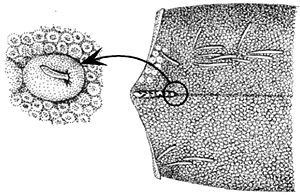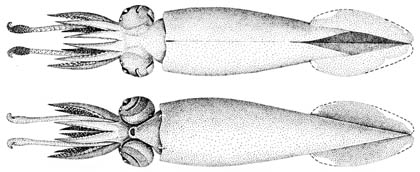Teuthowenia pellucida
Richard E. Young and Katharina M. Mangold (1922-2003)Introduction
Teuthowenia pellucida is a rather small squid that reaches a maximum size of about 200 mm ML. It occurs only in the southern hemisphere. Its systematics, biogeography and various aspects of its biology have been treated in detail by Voss (1985).
Characteristics
- Mantle
- Multipoint tubercle (2-4 points, occasionally 1-5 points) at each funnel-mantle fusion.
 image info
image info
Tubercles at funnel-mantle fusion, subadult female, 140 mm GL. From Voss, 1985. Printed with the permission of the Bulletin of Marine Science.
- Multipoint tubercle (2-4 points, occasionally 1-5 points) at each funnel-mantle fusion.
- Arms
- Arms I of males with 2-3 series of suckers on modified tips.
-
Arms II of males with 3-4 series of suckers on modified tips.
 image info
image info
This is the entire arm II of a mature male (201 mm GL) with the distal third and proximal sixth modified. From Voss, 1985. Printed with the permission of the Bulletin of Marine Science.
- Arms I and II of males with 11-18 normal suckers in midportion of arm, proximal to modified ends but distal to modified basal suckers.
- Diameter of largest arm III suckers 2.5 times basal suckers (about 2.0-2.2% of GL in diameter).
- Tentacles
- Largest club suckers with 26-32 teeth.
 image info
image info
Largest sucker from manus of club, female, 143 mm GL. From Voss, 1985. Printed with the permission of the Bulletin of Marine Science.
- Largest club suckers with 26-32 teeth.
Comments
Additional characteristics can be found here.
Life history
Growth stages have been described by Voss (1985).
The following information is from Voss (1995). Females mature between about 150 and 190 mm ML. At maturity the female undergoes marked morphological changes. The musculature becomes flaccid, the body is distended with mature eggs, photophores develop on the arm tips and glandular organs develop in the dorsal midline.The largest female measured by Voss was 201 mm ML. Mature females have nearly spherical eggs of 2.2 mm diameter. A single female carries about 6,000 - 8,000 eggs.
 image info
image info
Drawing of dorsal mantle showing glandular organs on midline, modified from Voss, 1985, mature female, 201 mm GL.
The series of small, glandular organs lies dorsal to the gladius at the anterior end of the mantle. The chambers of each organ open to the exterior via a hollow papilla. The function of these organs is unknown although Voss suggests that they secrete pheromones to attract males. Nearby spermatangia are commonly found embedded in the mantle tissue. This suggests another possible function for these organs: they may be seminal vesicles that store sperm derived from the spermatangia.
Mature females commonly have suckers encysted within tissues in the mantle cavity. Voss suggests that the suckers are lost from arms inserted into the mantle cavity by the male during mating behavior since the dentition of the two is identical. The photophores on the tips of arms IV (and probably the other arms but none of these have been seen intact) may function to attract males. Voss found pieces of body parts of T. pellucida in the stomachs of two mature females but refrained from concluding that cannabalism occurred during mating. The muscular deterioration, the near-absence of developing oocytes in mature females and possible cannabalism during mating suggests that the females are semelparous.
Males mature near 140 mm ML. Mature males have a long penis that extends well beyond the opening to the mantle cavity. At maturity the modified tips of arms I and II elongate. The finely-toothed suckers from these tips are commonly missing, presumably lost within the mantle cavity of some female. Also, at maturity the basal arm suckers become modified and the arms become more robust.
Distribution
Vertical distribution
Immature squid have been taken mostly in the upper 900 m of the water column while mature squid have been taken from depths of 1600 - 2400 m (Voss, 1985).
Geographical distribution
T. pellucida is found in a narrow circumglobal band in the region of the Southern Subtropical convergence about 40° S. lat.; this area is thought to be a distinct zoogeographical region (Voss, 1985).
References
Voss, N. A. 1980. A generic revision of the Cranchiidae (Cephalopoda; Oegopsida). Bull. Mar. Sci. 30: 365-412.
Voss, N. A. 1985. Systematics, biology and biogeography of the cranchiid cephalopod genus Teuthowenia (Oegopsida). Bull. Mar. Sci. 36: 1-85.
Title Illustrations
| Scientific Name | Teuthowenia pellucida |
|---|---|
| Reference | Voss, N. A. 1985. Systematics, biology and biogeography of the cranchiid cephalopod genus Teuthowenia (Oegopsida). Bull. Mar. Sci. 36: 1-85. |
| Sex | Female |
| Life Cycle Stage | subadult |
| View | dorsal, ventral |
| Size | 140 mm GL |
| Type | hypotype |
| Copyright | © 1985 Bulletin of Marine Science |
About This Page
Richard E. Young
Dept of Oceanography
University of Hawaii
Honolulu, Hawaii 96822
USA
Katharina M. Mangold (1922-2003)
Page copyright © 1999 Richard E. Young and Katharina M. Mangold (1922-2003)
Citing this page:
Young, Richard E. and Mangold (1922-2003), Katharina M. 1999. Teuthowenia pellucida . Version 01 January 1999 (complete). http://tolweb.org/Teuthowenia_pellucida/19615/1999.01.01 in The Tree of Life Web Project, http://tolweb.org/









